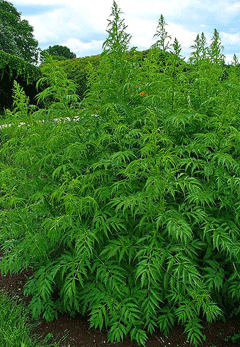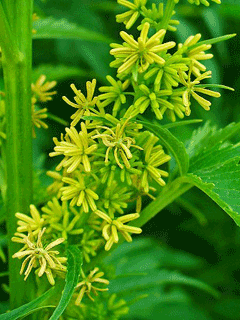 |
|
http://commons.wikimedia.org/wiki/User:Llez |
 |
| http://commons.wikimedia.org/wiki/User:Llez |
Translate this page:
Summary
Physical Characteristics

 Datisca cannabina is a PERENNIAL growing to 1.8 m (6ft) by 1 m (3ft 3in).
Datisca cannabina is a PERENNIAL growing to 1.8 m (6ft) by 1 m (3ft 3in).
See above for USDA hardiness. It is hardy to UK zone 8. It is in flower in September, and the seeds ripen in October. The species is dioecious (individual flowers are either male or female, but only one sex is to be found on any one plant so both male and female plants must be grown if seed is required). . The plant is not self-fertile.
Suitable for: light (sandy), medium (loamy) and heavy (clay) soils and prefers well-drained soil. Suitable pH: mildly acid, neutral and basic (mildly alkaline) soils. It cannot grow in the shade. It prefers moist soil.
UK Hardiness Map
US Hardiness Map
Synonyms
Plant Habitats
Meadow; Cultivated Beds;
Edible Uses
References More on Edible Uses
Medicinal Uses
Plants For A Future can not take any responsibility for any adverse effects from the use of plants. Always seek advice from a professional before using a plant medicinally.
Bitter Diuretic Febrifuge Odontalgic Purgative Sedative
The leaves and flowering stems are bitter, diuretic, febrifuge and purgative[145, 240]. The root is used as a sedative in the treatment of rheumatism[240]. It is also applied to carious teeth[240].
References More on Medicinal Uses
The Bookshop: Edible Plant Books
Our Latest books on Perennial Plants For Food Forests and Permaculture Gardens in paperback or digital formats.

Edible Tropical Plants
Food Forest Plants for Hotter Conditions: 250+ Plants For Tropical Food Forests & Permaculture Gardens.
More

Edible Temperate Plants
Plants for Your Food Forest: 500 Plants for Temperate Food Forests & Permaculture Gardens.
More

More Books
PFAF have eight books available in paperback and digital formats. Browse the shop for more information.
Shop Now
Other Uses
Dye
A yellow dye is obtained from the leaves, root and stems[46, 61, 145].
Special Uses
References More on Other Uses
Cultivation details
Requires a good deep soil and a sunny position[1, 200]. Plants can be grown in quite coarse grass, which can be cut annually in the autumn[233]. This species is not hardy in the colder areas of the country, it tolerates temperatures down to between -5 and -10°c[200]. Give the roots protection from winter frosts by mulching them[200]. At one time this plant was commonly cultivated as a dye plant[46, 61], but with the advent of chemical dyes it has fallen into disuse. Dioecious. Male and female plants must be grown if seed is required.
References Carbon Farming Information and Carbon Sequestration Information
Temperature Converter
Type a value in the Celsius field to convert the value to Fahrenheit:
Fahrenheit:
The PFAF Bookshop
Plants For A Future have a number of books available in paperback and digital form. Book titles include Edible Plants, Edible Perennials, Edible Trees,Edible Shrubs, Woodland Gardening, and Temperate Food Forest Plants. Our new book is Food Forest Plants For Hotter Conditions (Tropical and Sub-Tropical).
Shop Now
Plant Propagation
Seed - sow spring in a greenhouse, only just covering the seed. Germination usually takes place within 1 - 3 weeks at 18°c[164]. When large enough to handle, prick the seedlings out into individual pots and plant them out in the summer. Division in the spring. Very easy, larger clumps can be replanted direct into their permanent positions, though it is best to pot up smaller clumps and grow them on in a cold frame until they are rooting well. Plant them out in the spring.
Other Names
If available other names are mentioned here
Native Range
TEMPERATE ASIA: Afghanistan, Cyprus, Iran (north), Iraq, Lebanon, Turkey, Armenia, Azerbaijan, Georgia, Kyrgyzstan, Tajikistan, Uzbekistan TROPICAL ASIA: India (Himachal Pradesh, Jammu and Kashmir, Uttar Pradesh), Nepal, Pakistan (north) EUROPE: Greece (Kríti)
Weed Potential
Right plant wrong place. We are currently updating this section.
Please note that a plant may be invasive in one area but may not in your area so it's worth checking.
Conservation Status
IUCN Red List of Threatened Plants Status :

Growth: S = slow M = medium F = fast. Soil: L = light (sandy) M = medium H = heavy (clay). pH: A = acid N = neutral B = basic (alkaline). Shade: F = full shade S = semi-shade N = no shade. Moisture: D = dry M = Moist We = wet Wa = water.
Now available:
Food Forest Plants for Mediterranean Conditions
350+ Perennial Plants For Mediterranean and Drier Food Forests and Permaculture Gardens.
[Paperback and eBook]
This is the third in Plants For A Future's series of plant guides for food forests tailored to
specific climate zones. Following volumes on temperate and tropical ecosystems, this book focuses
on species suited to Mediterranean conditions—regions with hot, dry summers and cool, wet winters,
often facing the added challenge of climate change.
Read More
Expert comment
Author
L.
Botanical References
50200
Links / References
For a list of references used on this page please go here
Readers comment
© 2010, Plants For A Future. Plants For A Future is a charitable company limited by guarantee, registered in England and Wales. Charity No. 1057719, Company No. 3204567.